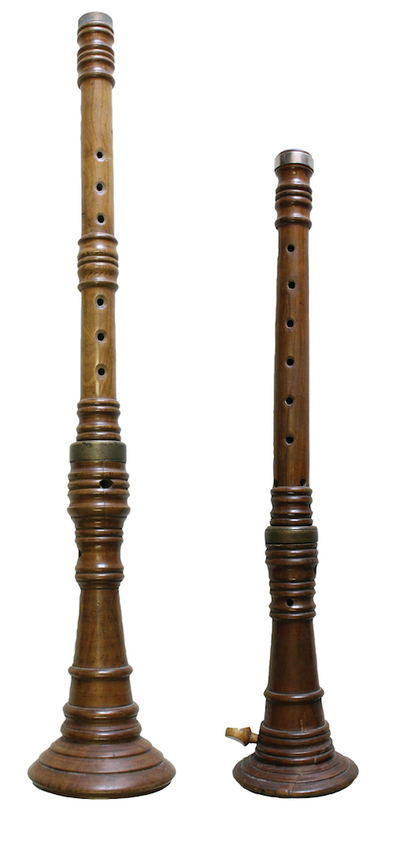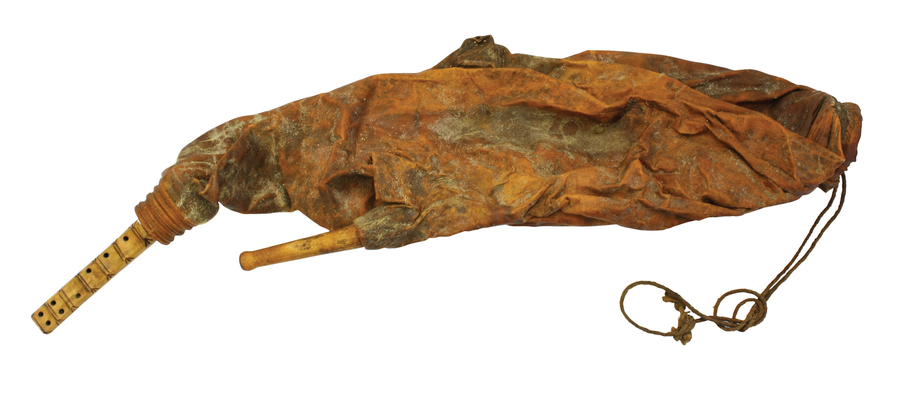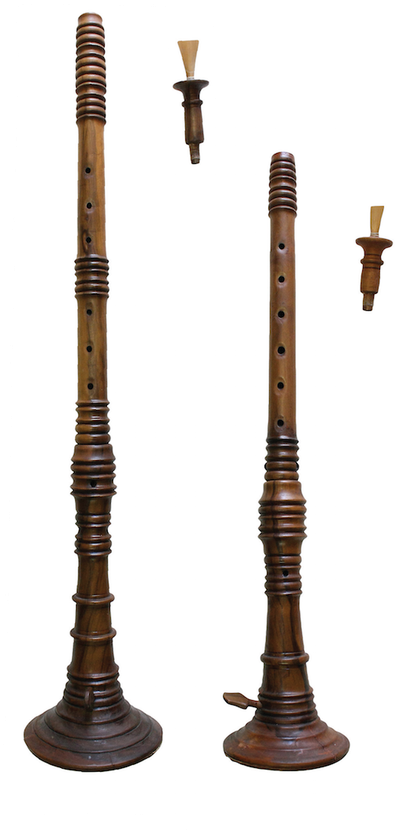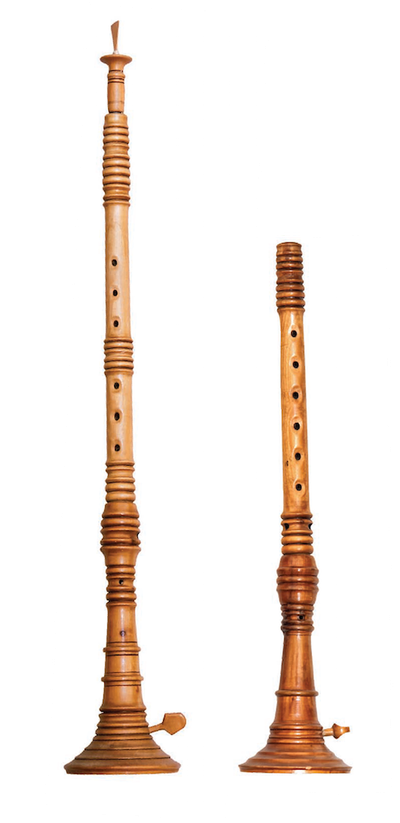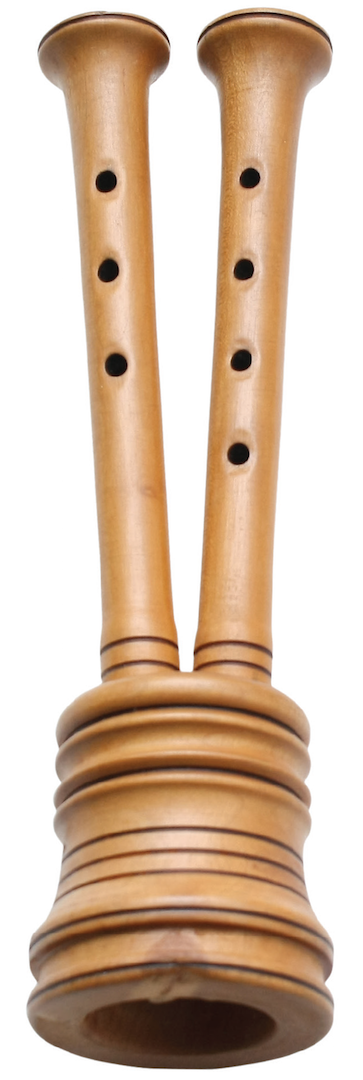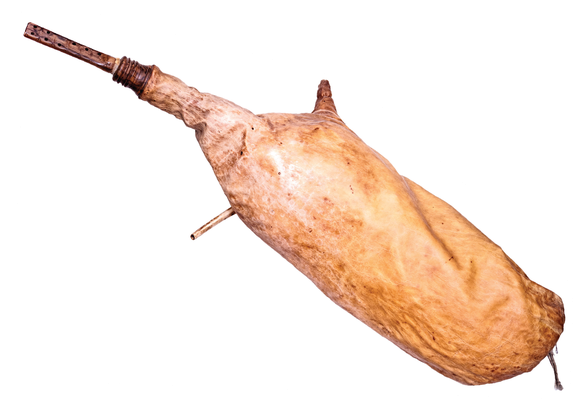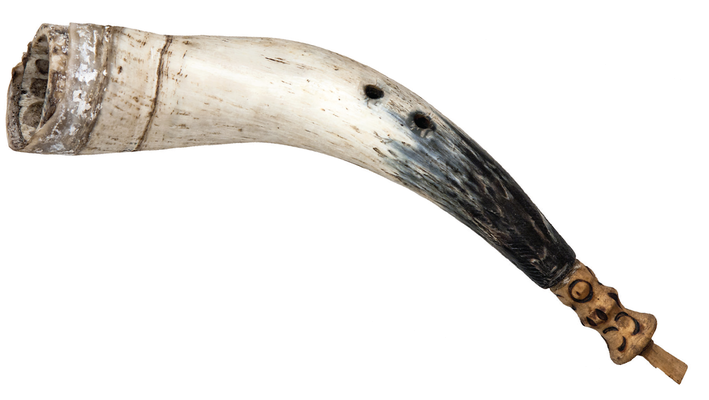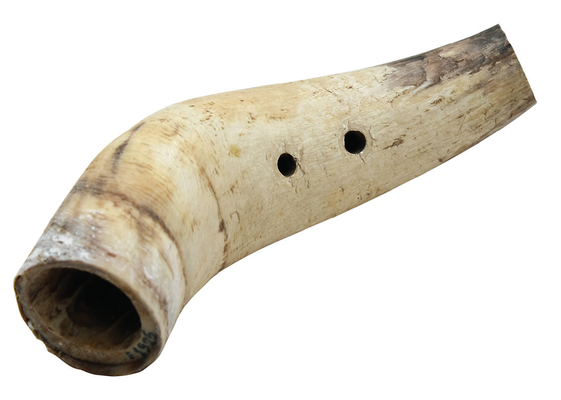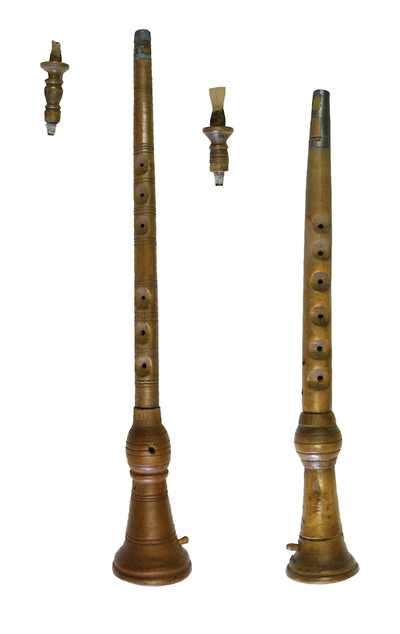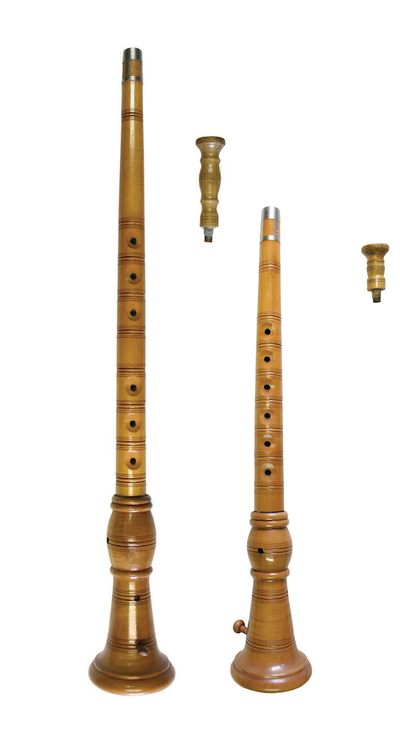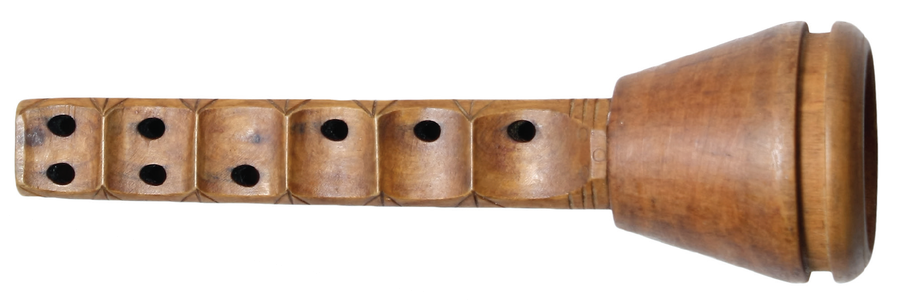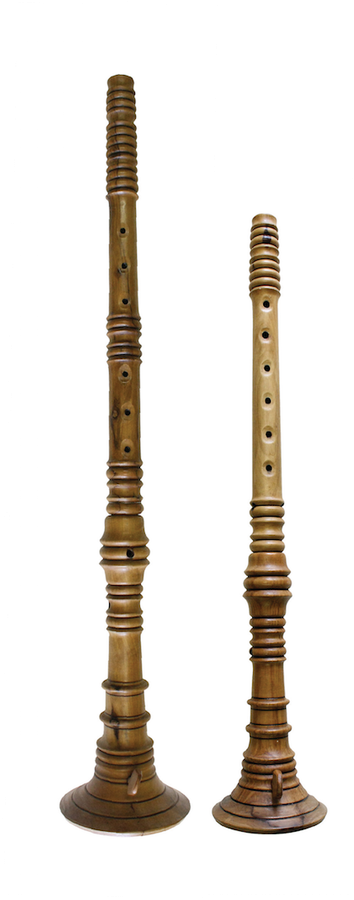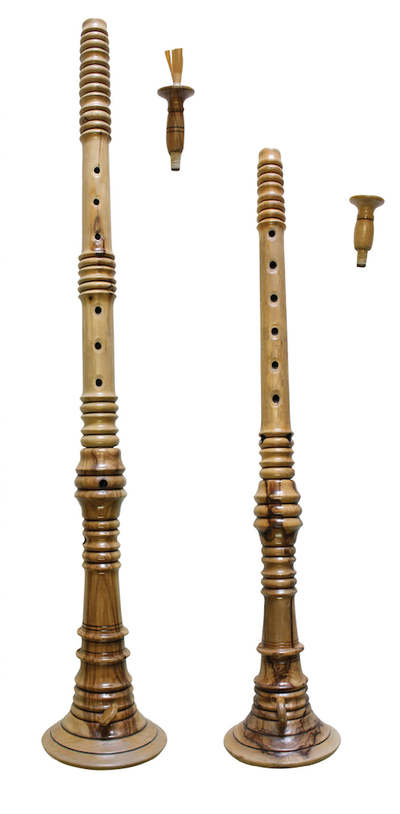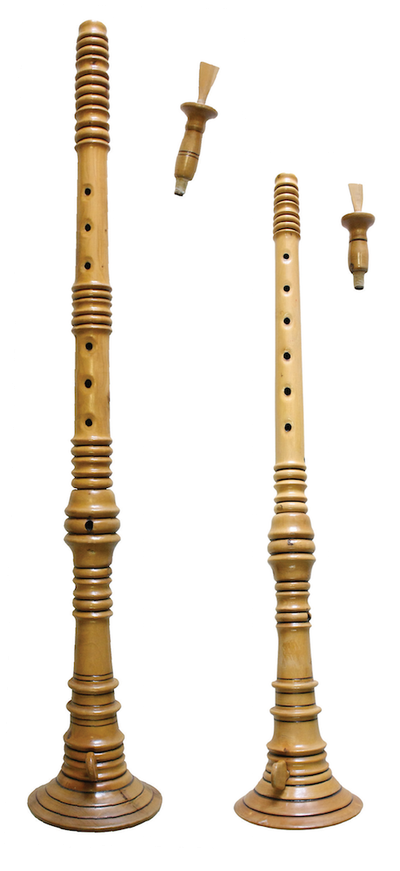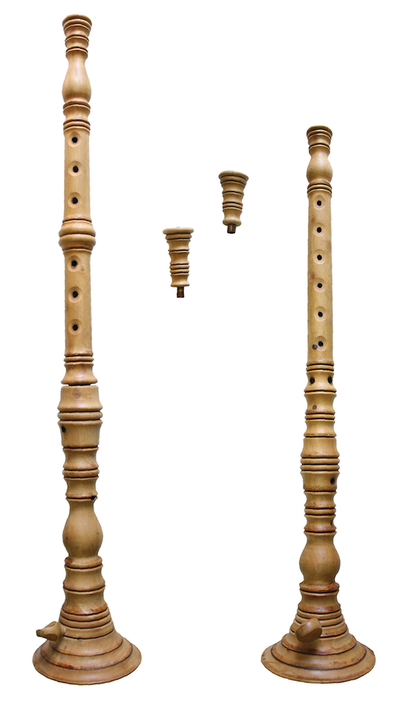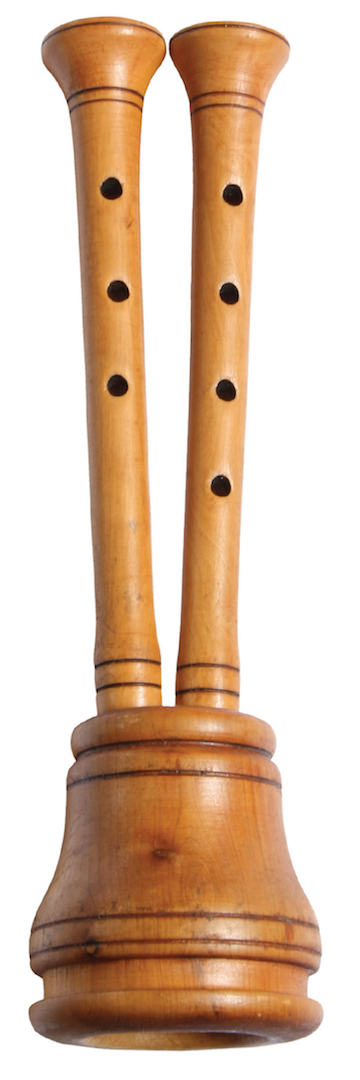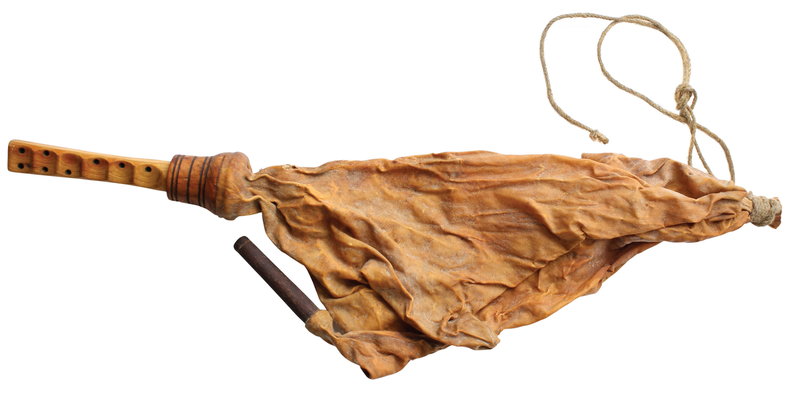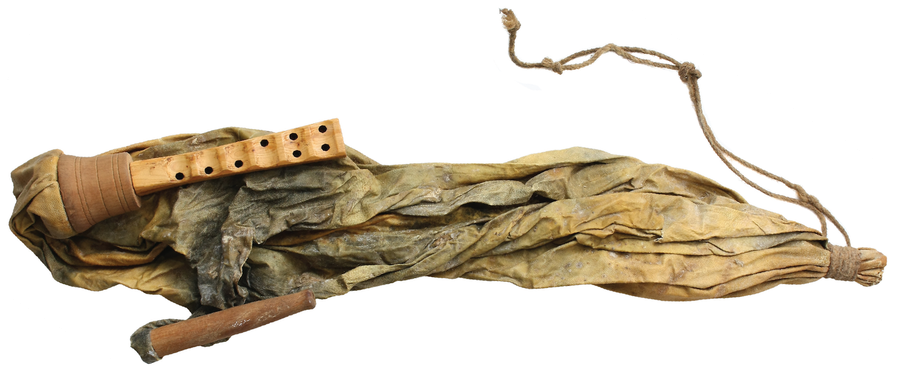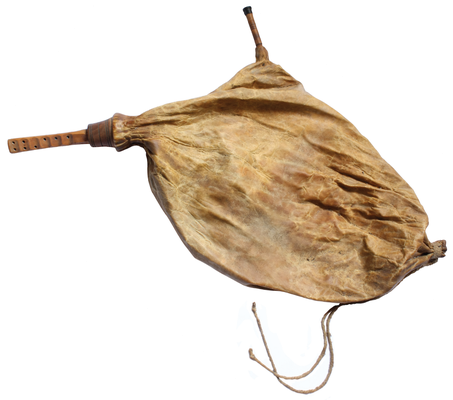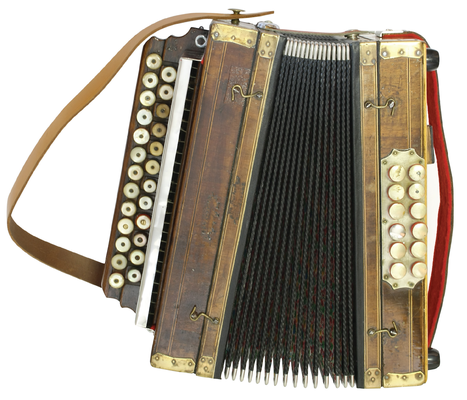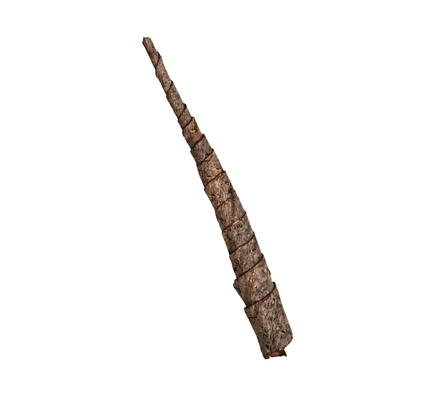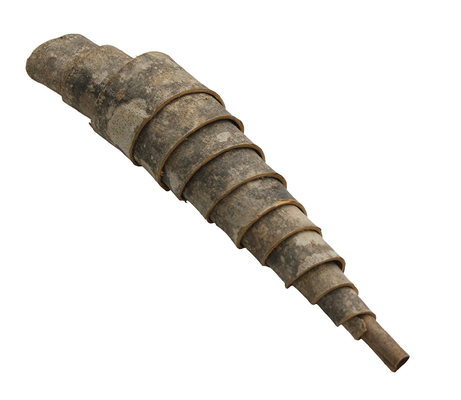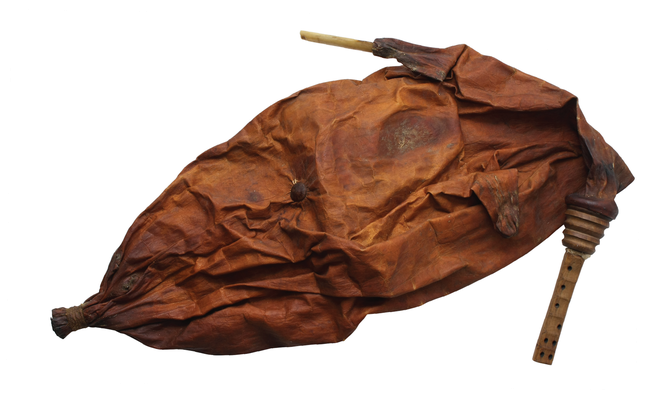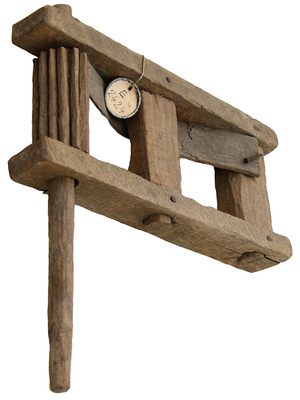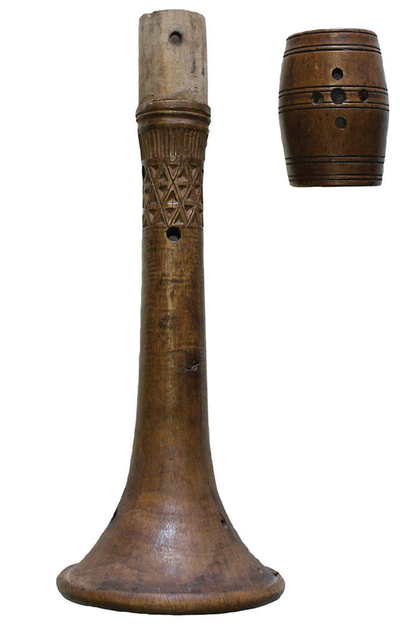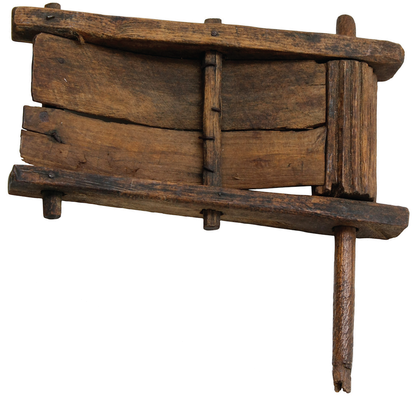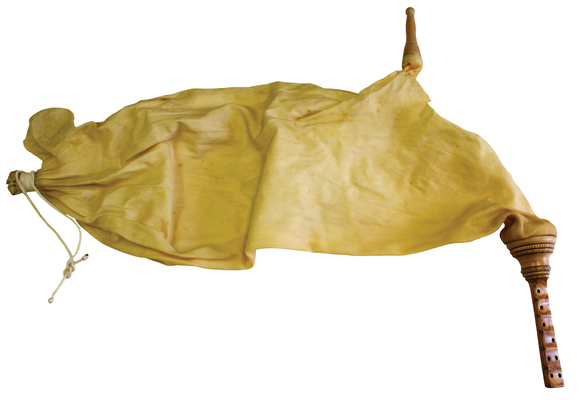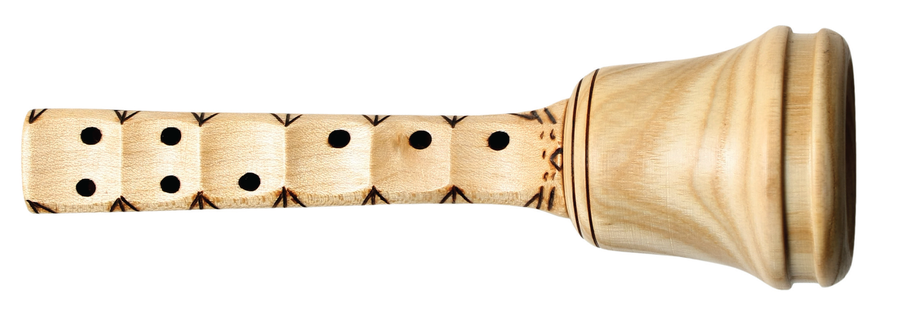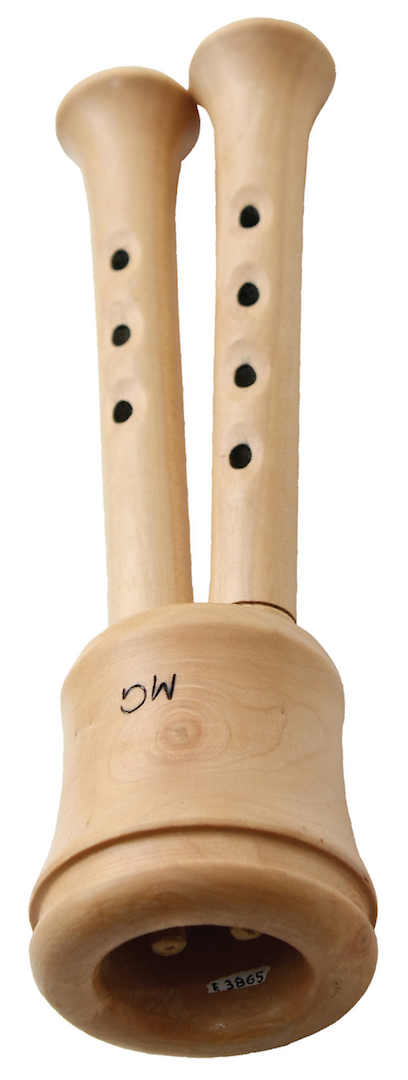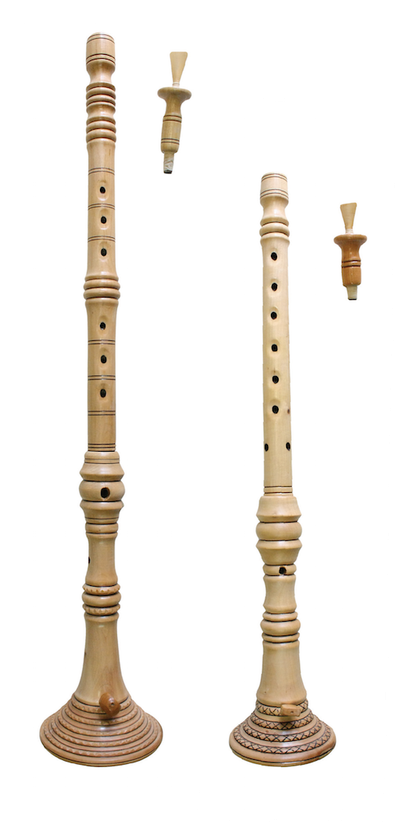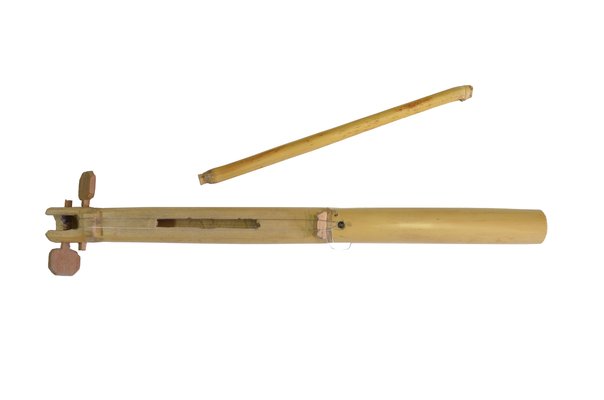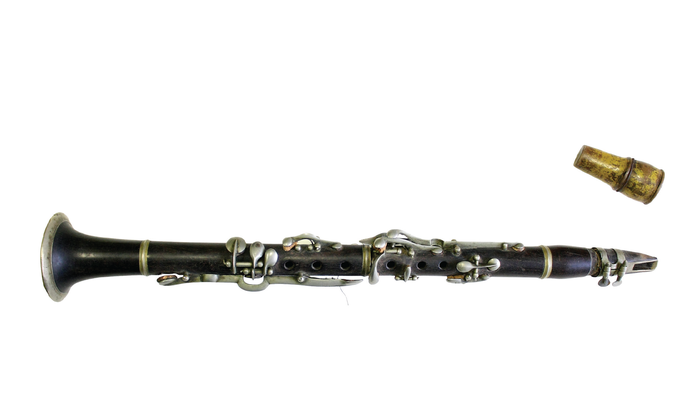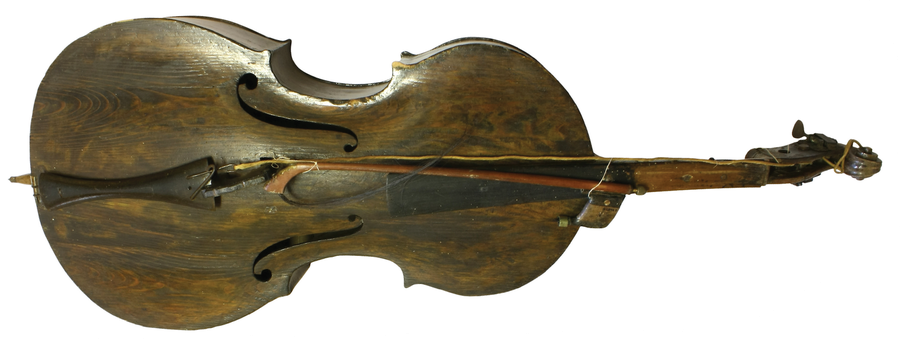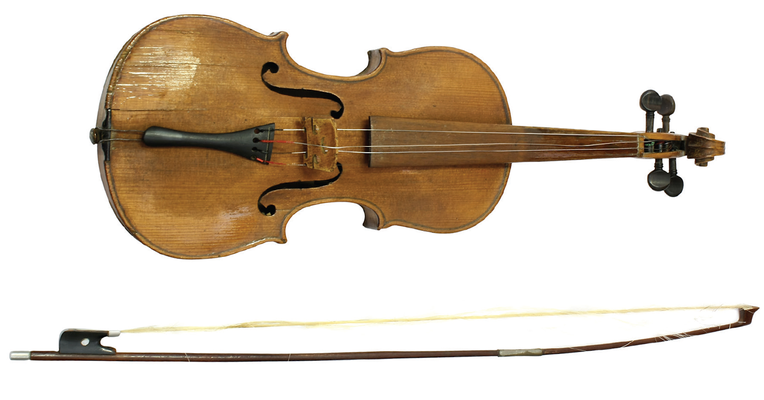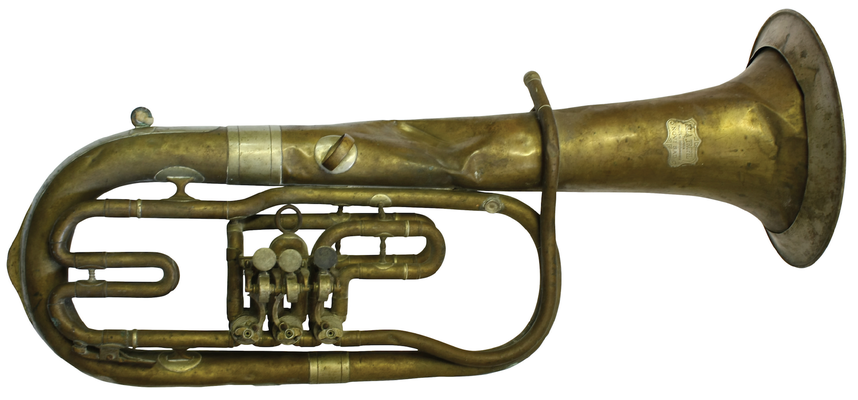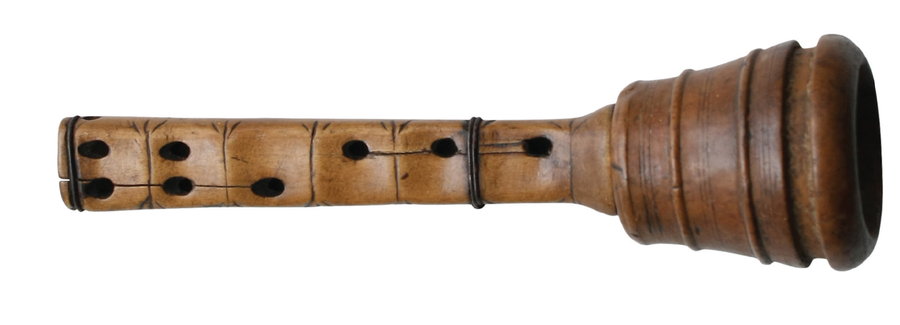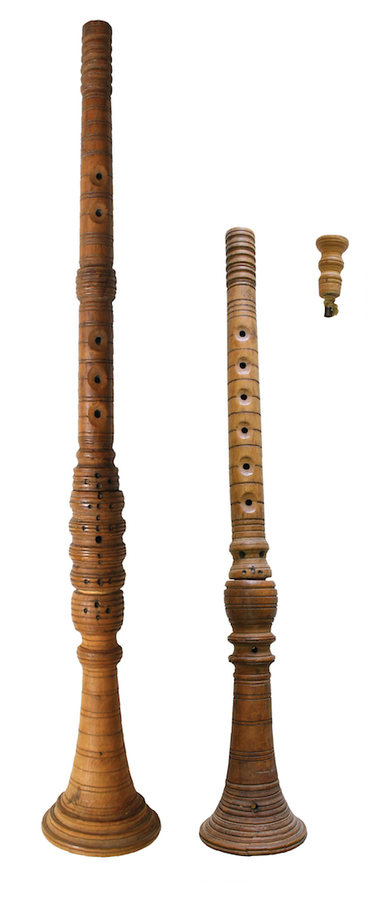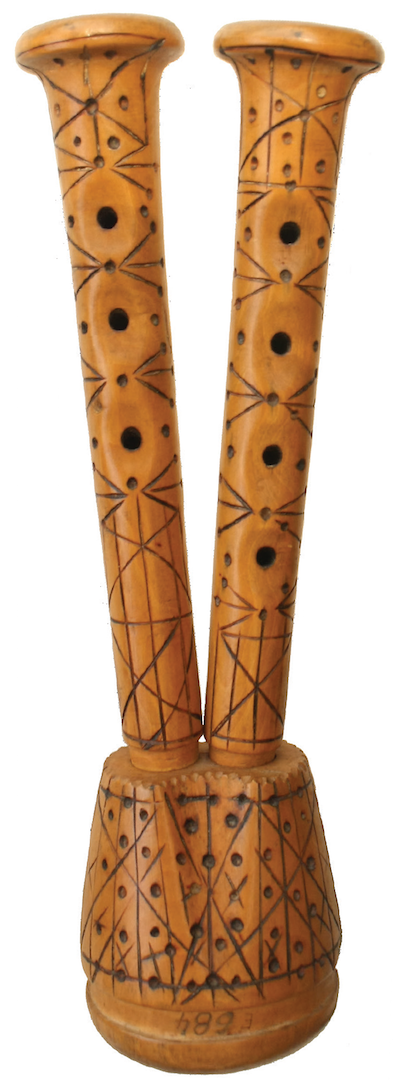Ethnographic Museum of Istria
- EMI-1779 - Dvojnice
- EMI-1780 - Šurle with the bag (Pive)
- EMI-1781 - Mišnice
- EMI-1785 i EMI-1784 - Great and small sopela
- EMI-1876 - Mišnice with the bag
- EMI-1878 - Sopelica
- EMI-1879 - Šurle
- EMI-1886 - Sopelica
- EMI-1887 - Mišnice
- EMI-1898 i EMI-1900 - Great and small sopela
- EMI-1899 i EMI-1901 - Great and small sopela
- EMI-1902 - Šurle
- EMI-1903 - Šurle
- EMI-1904 - Mišnice
- EMI-1905 - Mišnice
- EMI-1909 - Mišnice with the bag
- EMI-1924 - Horn pipes
- EMI-1925 - Horn pipes
- EMI-1973 i EMI-1974 - Great and small sopela
- EMI-1975 i EMI-1976 - Great and small sopela
- EMI-1981 - Šurle
- EMI-1982 - Mišnice
- EMI-1983 - Sopelica
- EMI-2157 i EMI-2158 - Great and small sopela
- EMI-2159 i EMI-2160 - Great and small sopela
- EMI-2161 i EMI-2162 - Great and small sopela
- EMI-2163 i EMI-2164 - Great and small sopela
- EMI-2165 i EMI-2166 - Great and small sopela
- EMI-2167 i EMI-2168 - Great and small sopela
- EMI-2169 - Mišnice
- EMI-2170 - Mišnice
- EMI-2171 - Mišnice
- EMI-2172 - Mišnice
- EMI-2173 - Šurle
- EMI-2175 - Dvojnice
- EMI-2177 - Dvojnice
- EMI-2178 - Dvojnice
- EMI-2179 - Mišnice with the bag
- EMI-2180 - Mišnice with the bag
- EMI-2181 - Mišnice with the bag
- EMI-2207 - Small sopela
- EMI-2258 - Diatonic accordion
- EMI-2340 - Horn pipes
- EMI-2341 - Bark pipes
- EMI-2342 - Bark pipes
- EMI-240 - Mišnice
- EMI-241 - Mišnice with the bag
- EMI-242 i EMI-243 - Great and small sopela
- EMI-2424 - Ratchet
- EMI-252 - The bell and the fontanelle of a great sopela
- EMI-2623 - Ratchet
- EMI-2684 - Small sopela
- EMI-2685 - Mišnice
- EMI-2686 - Mišnice
- EMI-2688 - Mišnice
- EMI-2689 - Mišnice
- EMI-2690 - Mišnice
- EMI-2861 - Sopelica
- EMI-3821 - Mišnice with the bag
- EMI-3864 - Mišnice
- EMI-3865 - Šurle
- EMI-3866 i EMI-3867 - Great and small sopela
- EMI-3868 - Dvojnice
- EMI-3869 - Mišnice with the bag
- EMI-4079 - Sopelica
- EMI-4207 i EMI-4208 - Great and small sopela
- EMI-4216 - Reed violin
- EMI-4682 - Clarinet
- EMI-4683 - Small double bass and bow
- EMI-4684 - Fiddle and bow
- EMI-5151 - Euphonium (Bombardin)
- EMI-5153 - Tamburica cindra
- EMI-618 - Mišnice
- EMI-621 - Dvojnice
- EMI-682 i EMI-683 - Great and small sopela
- EMI-684 - Šurle
- EMI-685 - Sopelica
- EMI-686 - Dvojnice
- EMI-7371 - Šurle
- EMI-7372 - Dvojnice sopelice
-
Dvojnice EMI-1779
Zbirka: Ethnographic Museum of IstriaBožidar Oplanić
1960.Wood, Hand made
A=345 E1=190 F=13,5 B=310 E2=22 G=5,5 C=50 E3=22 D=40 E4=25 The instrument original has five finger-holes on the right pipe and four on the left, but later on the first hole on each pipe was clogged. The thumb hole was drilled twice. The functioning hole is the one in level with the first plugged hole on the right pipe, and the second below the first open hole is clogged. The tubes are separated at the centre, and connected at the top and at the bottom. The instrument is richly decorated with hand-carved ornaments. The dvojnice are made outside Istria.
-
Šurle with the bag (Pive) EMI-1780
Zbirka: Ethnographic Museum of IstriaBožidar Oplanić
1969.Wood, Rope, Goat skin, Rubber, Woodturning, Hand made
chanter stock reeds A=210 E1=89 F= / H= d1= / B=18 E2=19,5 E7=69 I= Ø1= / C1=32 E3=22 F=6 J= d2= / C2=16 E4=23 G=4 Ø2= / D=9,5 E5=19,5 The right pipe of the instrument has five holes, and the left one four. The lowest hole on each tube serves as the vent-hole. On the right pipe there is a thumb hole drilled a little higher than usual and thus has a melodic function. The thumb hole was drilled later and the earlier, the original one was capped with a wooden stopper and wax. The chanter is noticeably larger than the other specimens. The left pipe is cracked at the top and it was clogged with wax and stitched with wire. The bag is made of goatskin. The blowpipe has an inserted piece of rubber tubing, and one leg is blocked with a wooden stopper. The instrument is painted brown.
-
Mišnice EMI-1781
Zbirka: Ethnographic Museum of IstriaBožidar Oplanić
1969. , Jakovići (Tinjan) / BeogradWood, Cane, Woodturning, Hand made
chanter stock reeds A=170 E1=44 E6=25 H=67 d1=46 B=20 E2=25 E7=44 I=53 Ø1=7 C1=25 E3=22 F=6 J=32 d2=45 C2=22 E4=24 G=5 Ø1=7 D=20 E5=25 The right pipe of the instrument has six finger-holes , and the left one has three. It is evident that at some point the fourth hole in the right pipe was clogged and then opened again. The mišnice are richly decorated with carved geometric motifs. The reeds are impregnated with hot oil. The instrument was made outside Istria.
-
Great and small sopela EMI-1785 i EMI-1784
Zbirka: Ethnographic Museum of IstriaBožidar Oplanić
1969.Wood, Metal, Woodturning
great A=590 E1=127 E5=27 E9= / B= / E2=27 E6=27 E10= / C=105 E3=27 E7=83 F=4 D=27 E4=67 E8=50 small A=450 E1=77 E5=28 E9=45 B= / E2=27 E6=28 E10=21 C=90 E3=28 E7=31 F=5 D=25 E4=28 E8=17 Great: The instrument has seven finger-holes while the seventh one (for the little finger) is double. the pipe has a vent-hole drilled through the pipe on both sides. The bell has two vent-holes, and one of them is drilled through the pipe on both sides. Rings made of brass and chromed iron are inserted on the upper parts of the bell and the pipe. the pipe and the bell are decorated with ridges and grooves made on a lathe. The sopela is painted with a brownish colour and varnished. The pirouette and the reed are missing.
Small: The instrument has six finger-holes . The bell has two vent-holes, and one of them is drilled through the pipe on both sides. A brass ring is inserted on the upper part of the bell. The instrument is decorated with rings and parallel ridges and grooves made on a lathe. The sopela is painted with a brownish colour and subsequently varnished. The pirouette and the reed are missing. -
Mišnice with the bag EMI-1876
Zbirka: Ethnographic Museum of IstriaAnton Peteh
1968. , Petešljari (Žminj)Wood, Rope, Goat skin, Woodturning, Hand made
chanter stock reeds A=137 E1=33 E6=15 H=54 d1= / B=15 E2=22 E7= / I=53 Ø1= / C1=21 E3=20 F=6 J=43 d2= / C2=24 E4=20 G=4 Ø2= / D=19 E5=20 The instrument has a standard number and arrangement of finger-holes . The chanter is decorated with double stripes and ornaments in the shape of an arrow made with an incandescent wire. The bag is bound with a wooden stopper on the bottom part (as on the bagpipes from Dalmatia and Hercegovina). The instrument lacks the reeds.
-
Sopelica EMI-1878
Zbirka: Ethnographic Museum of IstriaAnton Peteh
1970. , Petešljari (Žminj)Wood, Woodturning
A=310 D2=31 E5=23 B=255 E1=107 E6=21 C1=28 E2=21 F=16 C2=35 E3=20 G=8 D1=24 E4=21 H=4,5 The instrument has seven finger-holes ,one of which is a thumb hole on the lower side in line with the first. The sopelica is decorated with a larger number of turned thin parallel rings, ridges and grooves.
-
Šurle EMI-1879
Zbirka: Ethnographic Museum of IstriaAnton Peteh
oko 1970. , Petešljari (Žminj)Wood, Cane, Metal, Woodturning, Hand made
chanter stock reeds A=175 E1=73 F=5,7 H=57 d1=45 B=25 E2=18 G=4 I=52 Ø1=6 C1=32 E3=20 J=46 d2=40 C2=18 E4=23 Ø2=5,5 D=13 The right pipe of the instrument has four finger-holes, and the left one three. Already during the manufacture the left pipe was cracked and was therefore reinforced with iron rings. The stock is slightly concave on the front and on the rear side. The concavity slightly and gently spreads towards the chanters. The entire instrument is hand-decorated with dots and cruciform and parallel lines that create geometric motifs. The decorations are made with an incandescent wire. The pipes are made on a lathe, while the stock is completely handmade.
-
Sopelica EMI-1886
Zbirka: Ethnographic Museum of IstriaAnton Peteh
1970. , Petešljari (Žminj)Wood, Woodturning
A=290 D2= E5=22 B=243 E1=94,5 E6=19,5 C1=30 E2=21 F=14,6 C2=35 E3=20 G=8,3 D1=25 E4=21 H=4 The instrument has seven finger-holes, one of which is a thumb hole on the lower side in line with the first. The sopelica is decorated with a larger number of turned thin parallel rings, ridges and grooves. In addition, in some places, marks drawn in pencil are clearly visible. By comparison with other instruments of the same builder it can be assumed that this instrument has not been completed, and that the master had the intention to create additional ornaments. Due to a poor choice of material, the pipe twisted over time.
-
Mišnice EMI-1887
Zbirka: Ethnographic Museum of IstriaAnton Peteh
1970. , Petešljari (Žminj)Wood, Cane, Woodturning, Hand made
chanter stock reeds A=135 E1=32 E6=13,5 H=54 d1=45 B=15 E2=20 E7= / I=51 Ø1=6 C1=22 E3=20 F=6 J=40 d2=47 C2=20 E4=20 G=4 Ø2=6 D=20 E5=20 The instrument has a standard number and arrangement of finger holes. The chanter has no decorations. The stock is decorated with rings made on the lathe and it’s hand-notched at the bottom. The stock is slightly cracked.
-
Great and small sopela EMI-1898 i EMI-1900
Zbirka: Ethnographic Museum of IstriaMartin Glavaš
1973. , PulaWood, Cane, Metal, Woodturning
great A=600 E1=140 E5=29 E9= / B=50 E2=30 E6=29 E7-E10= / C=110 E3=27 E7=75 F=4 D=24 E4=57 E8=37 small A=450 E1=80 E5=26 E9= / B=40 E2=26 E6=26 E7-E10=75 C=90 E3=26 E7=30 F=4 D=20 E4=26 E8= / Great: The instrument has six finger-holes . The bell has two vent-holes, and one of them is drilled through the pipe on both sides. The sopela is decorated with ridges and grooves made on a lathe and with parallel rings made with an incandescent wire, also with the help of a lathe. The instrument is painted with a brownish colour and varnished.
Small: The instrument has six finger-holes and a vent-hole drilled through the pipe on both sides. The bell also has a vent-hole. The sopela is decorated with ridges and grooves made on a lathe and parallel rings made with an incandescent wire also with the help of a lathe. The instrument is painted brown and varnished. -
Great and small sopela EMI-1899 i EMI-1901
Zbirka: Ethnographic Museum of IstriaMartin Glavaš
1973. , PulaWood, Cane, Metal, Woodturning
great A=600 E1=140 E5=27 E9= / B=50 E2=27 E6=27 E7-E10= / C=100 E3=27 E7=78 F=4 D=23 E4=55 E8=41 small A=440 E1=77 E5=25 E9=44 B=43 E2=25 E6=25 E10=32 C=100 E3=25 E7=31 F=4,5 D=22 E4=25 E8= / Great: The instrument has six finger-holes . The bell has two vent-holes, and one of them is drilled through the pipe on both sides. The sopela is decorated with ridges and grooves made on a lathe and with parallel rings made with an incandescent wire, also with the help of a lathe. The instrument is lacquered with transparent varnish.
Small: The instrument has six finger-holes and a vent-hole drilled through the pipe on both sides. The bell also has a vent-hole. The sopela is decorated with ridges and grooves made on a lathe and parallel rings made with an incandescent wire also with the help of a lathe. The instrument is lacquered with transparent varnish. -
Šurle EMI-1902
Zbirka: Ethnographic Museum of IstriaMartin Glavaš
1973. , PulaWood, Cane, Olive, Woodturning
chanter stock reeds A=162 E1=69 F=6 H=60 d1=46 B=22 E2=20 G=4 I=56 Ø1=5,5 C1=28 E3=20 J=45 d2=43 C2=14 E4=20 Ø2=6,5 D=11 The right pipe of the instrument has four finger-holes, and the left one three. The pipes are decorated with parallel rings made with an incandescent wire on a lathe. The stock also has ring ornaments, and protrusions and grooves made on a lathe. There is a marked spot for a hole that was not drilled on the left pipe, in line with the first hole on the right pipe. The šurle are lacquered with transparent varnish.
-
Šurle EMI-1903
Zbirka: Ethnographic Museum of IstriaMartin Glavaš
1973. , PulaWood, Cane, Woodturning
chanter stock reeds A=163 E1=68 F=6 H=59 d1=44 B=21 E2=20 G=4 I=53 Ø1=6 C1=27 E3=20 J=46 d2=45 C2=14 E4=20 Ø2=6 D=11 The right pipe of the instrument has four finger-holes, and the left one three. The pipes are decorated with two parallel rings made with an incandescent wire on a lathe. The stock also has ring ornaments, and protrusions and grooves made on a lathe. The šurle are almost invisibly lacquered with transparent varnish.
-
Mišnice EMI-1904
Zbirka: Ethnographic Museum of IstriaMartin Glavaš
1973. , PulaWood, Cane, Woodturning, Hand made
chanter stock reeds A=146 E1=35 E6=19,5 H=55 d1=45 B=15 E2=19,5 E7= / I=50 Ø1=6 C1=26 E3=19,5 F=6 J=40 d2= / C2=23 E4=19,5 G=4 Ø2= / D=20 E5=19,5 The instrument has a standard number and arrangement of finger-holes . The chanter is decorated with ornaments in the shape of an arrow made with an incandescent wire. The stock has decorative grooves made on a lathe, and parallel rings made with an incandescent wire also with the help of a lathe. One reed is missing. The mišnice are lacquered with transparent varnish.
-
Mišnice EMI-1905
Zbirka: Ethnographic Museum of IstriaMartin Glavaš
1973. , PulaWood, Cane, Olive, Woodturning, Hand made
chanter stock reeds A=150 E1=38,5 E6=19,5 H=54,5 d1=45 B=15 E2=19,6 E7=140 I=46 Ø1=6 C1=24 E3=19,6 F=6 J=37 d2=45 C2=23 E4=20 G=4 Ø2=6 D=20 E5=19,5 The instrument has a standard number and arrangement of finger-holes . On each pipe there are side vent-holes. The chanter is decorated with ornaments in the shape of an arrow made with incandescent wire. The stock is decorated with grooves made on a lathe and with parallel rings made with an incandescent wire also made with the help of a lathe. The mišnice are lacquered.
-
Mišnice with the bag EMI-1909
Zbirka: Ethnographic Museum of IstriaMartin Glavaš
1973. , PulaWood, Cane, Bone, Woodturning, Hand made
chanter stock reeds A=153 E1=41 E6=19 H=57 d1=45 B=18 E2=19 E7= / I=46 Ø1=6 C1=24 E3=19 F=6 J=40 d2=48 C2=24 E4=19 G=4 Ø2=6 D=22 E5=19 The instrument has a standard number and arrangement of finger-holes . On each pipe there is a vent hole. The chanter is decorated with double stripes and ornaments in the shape of an arrow made with an incandescent wire. The stock has decorative groves made on a lathe and parallel rings made with an incandescent wire also with the help of a lathe. The blowpipe is made of sheep bone. The mišnice are lacquered with transparent varnish.
-
Horn pipes EMI-1924
Zbirka: Ethnographic Museum of Istria -
Horn pipes EMI-1925
Zbirka: Ethnographic Museum of Istria -
Great and small sopela EMI-1973 i EMI-1974
Zbirka: Ethnographic Museum of IstriaVinko Trubić
1933. , KrkWood, Cane, Metal, Woodturning
great A=550 E1=150 E5=33 E9= / B=60 E2=31 E6=31 E10= / C=80 E3=31 E7=79 F=4 D=23 E4=70 E8=38 small A=410 E1=117 E5=26 E9= / B=37 E2=22 E6=24 E10= / C=65 E3=23 E7=11 F=4 D=24 E4=29 E8= / Great: The instrument has six finger-holes . The bell has a vent-hole drilled on both sides. The upper part of the pipe is reinforced with cast lead. The sopela is decorated with parallel rings made on a lathe. These are the first sopele that the maker made and are typical of the island of Krk and the Kvarner bay.
Small: The instrument has six finger-holes . the pipe has two vent-holes drilled on both sides of the pipe. The upper part of the hand-made pipe is reinforced with cast lead. The bell is decorated with carved thin parallel rings and egg-shaped thickenings made on a lathe. It has a drilled hole that was blocked afterwards. The cracked bell is fixed at three points with iron staples. The maker is the father Vincent Trubić, a master whose sopele are also part of the holdings of the EMI. This type of sopela is characteristic of the area of the island of Krk and the Kvarner bay. -
Great and small sopela EMI-1975 i EMI-1976
Zbirka: Ethnographic Museum of IstriaVinko Trubić
1973. , KrkWood, Metal, Woodturning
great A=575 E1=183 E5=31 E9= / B=80 E2=31 E6=32 E10= / C=80 E3=32 E7=70 F=4,5 D=26 E4=65 E8=48 small A=415 E1=115 E5=24 E7-E9=51 B=40 E2=24 E6=24 E10=37 C=70 E3=24 E7=12 F=4,5 D=25 E4=24 E8= / Great: The instrument has six finger-holes . The bell has two vent-holes and the bottom one is drilled on both sides of the pipe. The upper part of the pipe is reinforced with cast lead. The sopele are decorated with parallel rings made on a lathe, and the bell has an egg-shaped thickening. The instrument is painted and lacquered. The pirouette lacks the reed. This type of sopela is characteristic of the area of the island of Krk and the Kvarner bay.
Small: The instrument has six finger-holes . the pipe has two vent-holes drilled on both side of the pipe. The upper part of the pipe is reinforced with cast lead. The sopela is decorated with parallel rings made on a lathe. The bell is thickened with the help of a lathe and it has two vent-holes with the bottom one drilled on both sides of the pipe. The instrument is painted and lacquered. The pirouette lacks the reed. This type of sopela is characteristic of the area of the island of Krk and the Kvarner bay. -
Šurle EMI-1981
Zbirka: Ethnographic Museum of IstriaAnton Peteh
1973. , Petešljari (Žminj)Wood, Cane, Hand made
chanter stock reeds A=163 E1=61 F=5 H=64 d1=46 B=21 E2=19,5 G=4 I=51 Ø1=5,5 C1=28 E3=18 J=50 d2=46 C2=19 E4=20 Ø1=5,5 D=15 The right pipe of the instrument has four finger-holes, and the left one three. The stock is slightly concave on the front and on the rear side. The concavity slightly and gently spreads towards the chanters. The front side of the instrument is hand-decorated with cruciform and parallel lines which seem to be positioned asymmetrically. The instrument is completely handmade.
-
Mišnice EMI-1982
Zbirka: Ethnographic Museum of IstriaAnton Peteh
1973. , Petešljari (Žminj)Wood, Cane, Woodturning, Hand made
chanter stock reeds A=146 E1=35 E6=20 H=53,5 d1=40 B=15 E2=20 E7=127 I=55 Ø1=7 C1=21 E3=20 F=6,8 J=33 d2=43 C2=23 E4=20 G=4 Ø2=7 D=21 E5=20 The instrument has a standard number and arrangement of finger-holes . On each pipe there are side vent-holes. The chanter is decorated with carved ornaments in the shape of arrows and with tiny carved circles.
-
Sopelica EMI-1983
Zbirka: Ethnographic Museum of IstriaAnton Peteh
1973. , Petešljari (Žminj)Wood, Woodturning
A=318 D2=/ E5=21 B=269 E1=113 E6=21 C1=31 E2=20 F=14 C2=31 E3=20 G=9,5 D1=24 E4=20 H=4,5 The instrument has seven finger-holes, one of which is a thumb hole on the lower side in line with the first. The sopelica is decorated with a larger number of turned thin parallel rings, ridges and grooves.
-
Great and small sopela EMI-2157 i EMI-2158
Zbirka: Ethnographic Museum of IstriaMartin Glavaš
1974. , PulaWood, Woodturning
great A=600 E1=137 E5=29 E9= / B= / E2=28 E6=28 E10= / C=103 E3=28 E7=79 F=4 D=24 E4=58 E8=40 small A=460 E1=77 E5=25 E9= / B= / E2=24 E6=25 E7-E10=106 C=85 E3=25 E7=28 F=4 D=22 E4=25 E8= / Great: The instrument has six finger-holes . The bell has two vent-holes, and one of them is drilled through the pipe on both sides. The sopela is decorated with ridges and grooves made on a lathe and with parallel rings made with an incandescent wire, also with the help of a lathe. The instrument is lacquered with transparent varnish. The pirouette and the reed are missing.
Small: The instrument has six finger-holes and a vent-hole drilled through the pipe on both sides. The bell also has a vent-hole. The sopela is decorated with ridges and grooves made on a lathe and parallel rings made with an incandescent wire also with the help of a lathe. The instrument is lacquered with transparent varnish. Part of the bell is broken off and the pirouette and the reed are missing. -
Great and small sopela EMI-2159 i EMI-2160
Zbirka: Ethnographic Museum of IstriaMartin Glavaš
1974. , PulaWood, Cane, Olive, Metal, Woodturning
great A=600 E1=140 E5=28 E9= / B=53 E2=26 E6=28 E10= / C=100 E3=28 E7=78 F=4 D=26 E4=59 E8=45 small A=470 E1=75 E5=26 E9= / B=40 E2=25 E6=26 E7-E10=95 C=90 E3=26 E7=28 F=4 D=21 E4=26 E8= / Great: The instrument has six finger-holes . The bell has two vent-holes, and one of them is drilled through the pipe on both sides. The sopela is decorated with ridges and grooves made on a lathe and with parallel rings made with an incandescent wire, also with the help of a lathe. The instrument is lacquered with transparent varnish.
Small: The instrument has six finger-holes and a vent-hole drilled through the pipe on both sides. The bell also has a vent-hole. The sopela is decorated with ridges and grooves made on a lathe and parallel rings made with an incandescent wire also with the help of a lathe. The instrument is lacquered with transparent varnish. The pirouette lacks the reed. -
Great and small sopela EMI-2161 i EMI-2162
Zbirka: Ethnographic Museum of IstriaMartin Glavaš
1974. , PulaWood, Cane, Metal, Woodturning
great A=600 E1=140 E5=27 E9= / B=55 E2=27 E6=27 E10= / C=100 E3=27 E7=74 F=4 D=26 E4=60 E8=45 small A=460 E1=75 E5=26 E9= / B=42 E2=26 E6=26 E7-E10=105 C=85 E3=26 E7=21 F=4 D=20 E4=26 E8= / Great: The instrument has six finger-holes . The bell has two vent-holes, and one of them is drilled through the pipe on both sides. The sopela is decorated with ridges and grooves made on a lathe and with parallel rings made with an incandescent wire, also with the help of a lathe. The instrument is lacquered with transparent varnish.
Small: The instrument has six finger-holes and a vent-hole drilled through the pipe on both sides. The bell also has a vent-hole. The sopela is decorated with ridges and grooves made on a lathe and parallel rings made with an incandescent wire also with the help of a lathe. The instrument is lacquered with transparent varnish. -
Great and small sopela EMI-2163 i EMI-2164
Zbirka: Ethnographic Museum of IstriaMartin Glavaš
1974. , PulaWood, Cane, Metal, Woodturning
great A=600 E1=138 E5=29 E9= / B=55 E2=28 E6=30 E10= / C=100 E3=29 E7=83 F=4 D=22 E4=60 E8=55 small A=460 E1=77 E5=27 E9= / B=43 E2=27 E6=26 E7-E10=99 C=85 E3=26 E7=25 F=4 D=20 E4=27 E8= / Great: The instrument has six finger-holes . The bell has two vent-holes, and one of them is drilled through the pipe on both sides. The sopela is decorated with ridges and grooves made on a lathe and with parallel rings made with an incandescent wire, also with the help of a lathe. The instrument is coloured with a reddish-brown colour and varnished.
Small: The instrument has six finger-holes and a vent-hole drilled through the pipe on both sides. The bell also has a vent-hole. The sopela is decorated with ridges and grooves made on a lathe and parallel rings made with an incandescent wire also with the help of a lathe. The instrument is coloured with a reddish-brown colour and varnished. During the making of the instrument the back of the pipe was drilled with seven holes (presumably by mistake) that were later blocked with wooden plugs and a mixture of wood glue and sawdust. -
Great and small sopela EMI-2165 i EMI-2166
Zbirka: Ethnographic Museum of IstriaVinko Trubić
1973. , KrkWood, Cane, Metal, Woodturning
great A=560 E1=163 E5=30 E9= / B=60 E2=30 E6=30 E10= / C=80 E3=30 E7=51 F=4 D=23 E4=59 E8=23 small A=420 E1=115 E5=25 E7-E9=65 B=30 E2=25 E6=25 E10=30 C=75 E3=25 E7=25 F=4 D=22 E4=25 E8= / Great: The instrument has six finger-holes . The bell has two vent-holes and the bottom one is drilled on both sides of the pipe. The sopela is decorated with parallel rings made with an incandescent wire on a lathe. The bell has egg-shaped thickenings. The sopele are painted and lacquered.
Small: The instrument has six finger-holes . the pipe has two vent-holes drilled on both side of the pipe. The sopela is decorated with parallel rings made with an incandescent wire on a lathe. The bell is thickened with the help of a lathe and it has two vent-holes with the bottom one drilled on both sides of the pipe. The instrument is painted and lacquered. This type of sopela is characteristic of the area of the island of Krk and the Kvarner bay. -
Great and small sopela EMI-2167 i EMI-2168
Zbirka: Ethnographic Museum of IstriaMario Sandrić
1974. , Butkovići, PulaWood, Metal, Woodturning
vela A=600 E1=128 E5=28 E9= / B=54 E2=28 E6=30 E10= / C=100 E3=30 E7=90 F=4,5 D=26 E4=58 E8=60 mala A=460 E1=75 E5=28 E9= / B=45 E2=25 E6=2 E7-E10=81 C=95 E3=25 E7=60 F=4 D=22 E4=25 E8= / Great: The instrument has six finger-holes . The bell has two vent-holes and one of them is drilled through the pipe on both sides. The sopela is decorated with ridges and grooves made on a lathe and parallel rings made with an incandescent wire also with the help of a lathe. The bell of the sopela is slightly cracked. The instrument is painted or varnished in a bright shade of brown. The pirouette lacks the reed.
Small: The instrument has seven finger-holes on the pipe and the seventh hole (for the little finger) is double. The bell has a vent-hole drilled on both sides. The sopela is decorated with ridges and grooves made on a lathe and parallel rings made with an incandescent wire also with the help of a lathe. The instrument is painted or varnished in a bright shade of brown. The pirouette lacks the reed. -
Mišnice EMI-2169
Zbirka: Ethnographic Museum of IstriaRomano Živić
1974. , CereWood, Cane, Woodturning, Hand made
chanter stock reeds A=145,5 E1=44 E6=17,4 H=54 d1=36 B=15 E2=23,5 E7=140 I=44 Ø1=6,6 C1=23,5 E3=21 F=6 J=33 d2= / C2=22 E4=19,5 G=4 Ø2= / D=20 E5=17,4 The instrument has a standard number and arrangement of finger-holes . The chanter is decorated with ornaments in the shape of an arrow made with incandescent wire. The fourth and fifth holes are not drilled on both barrels on the same level (probably accidentally). On the left pipe there is a side vent hole, perhaps subsequently drilled. The stock has decorative grooves made on a lathe and parallel rings made with incandescent wire also with the help of a lathe. One reed is missing. The mišnice are lacquered with a light yellowish varnish.
-
Mišnice EMI-2170
Zbirka: Ethnographic Museum of IstriaRomano Živić
1974. , CereWood, Cane, Woodturning, Hand made
chanter stock reeds A=156 E1=40 E6=20,3 H=56,5 d1=36 B=15 E2=20,3 E7= / I=48 Ø1=6,5 C1=24 E3=20,3 F=6 J=38 d2=36 C2=23 E4=20,3 G=4 Ø2=6 D=20 E5=20,3 The instrument has a standard number and arrangement of finger-holes . The chanter is decorated with carved ornaments in the shape of an arrow. The stock is decorated with hand-carved geometric designs. The mišnice are lacquered with a light yellowish varnish.
-
Mišnice EMI-2171
Zbirka: Ethnographic Museum of IstriaRomano Živić
1974. , CereWood, Cane, Woodturning, Hand made
chanter stock reeds A=163 E1=44 E6=18 H=54 d1=37 B=15 E2=24 E7= / I=47 Ø1=7 C1=25 E3=22 F=6,5 J=36 d2= / C2=22 E4=22 G=4 Ø2= / D=20 E5=23 The instrument has a standard number and arrangement of finger-holes . The stock is decorated with hand-carved geometric designs. The mišnice are lacquered with a light yellowish varnish.
-
Mišnice EMI-2172
Zbirka: Ethnographic Museum of IstriaMartin Glavaš
1974. , PulaWood, Cane, Olive, Woodturning, Hand made
chanter stock reeds A=147 E1=33 E6=20 H=59 d1=50 B=14 E2=20 E7=140 I=52 Ø1=6,5 C1=22 E3=20 F=6 J=38 d2=47 C2=21 E4=20 G=4 Ø2=6,5 D=20 E5=20 The instrument has a standard number and arrangement of finger-holes . On each pipe there is a side vent hole. The chanter is decorated with ornaments in the shape of an arrow made with an incandescent wire. The stock has decorative grooves made on a lathe and parallel rings made with incandescent wire also with the help of a lathe. The mišnice are lacquered with transparent varnish.
-
Šurle EMI-2173
Zbirka: Ethnographic Museum of IstriaMartin Glavaš
1974. , PulaWood, Cane, Woodturning
chanter stock reeds A=53 E1=60 F=6 H=60 d1=46,5 B=13 E2=19 G=4 I=54 Ø1=6,7 C1=25 E3=19 J=39 d2=48,5 C2=11,5 E4=20 Ø1=6,4 D=10,5 The right pipe of the instrument has four finger-holes, and the left one three. There are no indentations for fingers on the chanters. The pipes are decorated with grooves made on a lathe and parallel rings made with an incandescent wire also with the help of a lathe. The stock also has ring decorations. The šurle are lacquered with transparent varnish..
-
Dvojnice EMI-2175
Zbirka: Ethnographic Museum of IstriaMartin Glavaš
1974. , PulaWood, Hand made
A=340 D=39 E4=25 B=294 E1=175 E5=180 C1=44 E2=25 F=13 E3=26 G=4,5 The instrument has four finger-holes on the right pipe and three on the left. The thumb hole is on the right pipe, level with the first hole. At the top, middle and bottom of the instrument there are geometric decorations made by an incandescent wire. The dvojnice are coloured brown and varnished.
-
Dvojnice EMI-2177
Zbirka: Ethnographic Museum of IstriaMartin Glavaš
1974. , PulaWood, Montpellier Maple, Hand made
A=335 D=35 E4=20 B=285 E1=187 E5=187 C=44 E2=20 F=14 E3=20 G=4,5 The instrument has four finger-holes on the right pipe and three on the left. The thumb hole is on tthe right pipe, level with the first hole. At the top, middle and bottom of the instrument there are geometric decorations and dots made by an incandescent wire. The dvojnice are varnished with clear varnish.
-
Dvojnice EMI-2178
Zbirka: Ethnographic Museum of IstriaMartin Glavaš
1974. , PulaWood, Montpellier Maple, Hand made
A=289 D=37 E4=18 B=243 E1=142 E5=142 C=43 E2=19 F=12 E3=18 G=4 The instrument has four finger-holes on the right pipe and three on the left. The thumb hole is on the right pipe, level with the first hole. At the top, middle and bottom of the instrument there are geometric decorations and dots made by an incandescent wire. The dvojnice are varnished with clear varnish.
-
Mišnice with the bag EMI-2179
Zbirka: Ethnographic Museum of IstriaRomano Živić
1974. , CereWood, Cane, Skin, Rope, Woodturning, Hand made
chanter stock reeds A=150 E1=31 E6=20 H=61 d1=46 B=13 E2=22 E7= / I=53 Ø1=6 C1=27 E3=22 F=6 J=39 d2=44 C2=23 E4=22 G=4 Ø2=6 D=21 E5=19 The instrument has a standard number and arrangement of finger-holes . The chanter has no special decorations. The stock has parallel rings made with an incandescent wire with the help of a lathe. The bag is made of goatskin. The blowpipe is wooden. The mišnice are impregnated with linseed oil.
-
Mišnice with the bag EMI-2180
Zbirka: Ethnographic Museum of IstriaRomano Živić
1974. , CereWood, Cane, Skin, Rope, Woodturning, Hand made
chanter stock reeds A=160 E1=44 E6=20 H=62 d1=42 B=12 E2=20 E7= / I=55 Ø1=6 C1=26 E3=20 F=5,5 J=41 d2=47 C2=22 E4=20 G=5 Ø2=6 D=21 E5=20 The instrument has a standard number and arrangement of finger-holes. There is an expressed divergence in the chanter - the lower part tapers upward and then it expands rapidly. The chanter has no special decorations. The stock has parallel rings made with a lathe. The bag is made of goatskin. The blowpipe is wooden. The mišnice are impregnated with linseed oil.
-
Mišnice with the bag EMI-2181
Zbirka: Ethnographic Museum of IstriaRomano Živić
1974. , CereWood, Skin, Rope, Rubber, Woodturning, Hand made, Leather processing
chanter stock reeds A=153 E1=49 E6=17 H=60 d1= / B=13,5 E2=21 E7= / I=54 Ø1= / C1=26 E3=19,5 F=5,5 J=41 d2= / C2=25 E4=18,5 G=4 Ø2= / D=21 E5=18,5 The instrument has a standard number and arrangement of finger-holes . The chanter has no special decorations. The stock is decorated with parallel rings made with an incandescent wire on a lathe. The bag is made of goatskin. The blowpipe is wooden with a rubber tube on top. The instrument lacks the reeds.
-
Small sopela EMI-2207
Zbirka: Ethnographic Museum of IstriaMate Maružin-Žliga
1925. , KanfanarWood, Cane, Metal, Woodturning
A=430 E1=75 E5=25 E9= / B=40 E2=23 E6=23 E7-E10=57 C=90 E3=25 E7=25 F=5 D=25 E4=23 E8= / The instrument has seven finger-holes on the pipe and the seventh hole (for the little finger) is double. The bell has a vent-hole drilled on both sides. The upper part of the pipe is reinforced with an iron ring. The bell is also reinforced with iron rings at the bottom and at the top, but the latter one is missing. The sopela is decorated with thin rings, ridges and grooves made on a lathe. The instrument is painted with a brown colour. The reed and pirouette may not be original.
-
Diatonic accordion EMI-2258
Zbirka: Ethnographic Museum of IstriaAnonymous
oko/cca 1920.Wood, Leather, Metal, Cardboard, Canvas, Nacre, Craftsmanship
L (length)=280 mm; H (hight)=280 mm; W (width)=170 mm
Diatonic accordion with 12 basses in the key of F / B-flat, localy known as " armonika trieština". The corpus is made of wood. It has 25 mother of pearl buttons, while those for basses are metal. The instrument is painted with colourful floral motifs. It was restored in recent times. The stamp of the maker is not readable, and as a place of origin the same seal mentions "Sušak-Fiume". Its newer brown belt is made of leather.
-
Horn pipes EMI-2340
Zbirka: Ethnographic Museum of Istria
oko/intorno/about 1930.Cane, Animal horn, Hand made
L (length) = 175 mm; Ø (diameter) = 70 mm
Labial pipes made of bovine horn. On the upper side of the horn a labial handmade mouthpiece is inserted. The instrument has no holes, so it produces basicaly only a single note. Opening and closing the lower opening by hand increases or decreases the air chamber. This enables the production of different tones.
-
Bark pipes EMI-2341
Zbirka: Ethnographic Museum of Istria -
Bark pipes EMI-2342
Zbirka: Ethnographic Museum of Istria -
Mišnice EMI-240
Zbirka: Ethnographic Museum of IstriaAnica Popović
oko 1920.Boxwood, Cane, Woodturning, Hand made, Carving
chanter stock reeds A=135 E1=31 E6=19 H=49 d1=38 B=15 E2=22 E7=122 I=43 Ø1=6,5 C1=26 E3=17 F=6,5 J=33 d2=45 C2=20 E4=18 G=4,3 Ø1=6,5 D=20 E5=17 The instrument has a standard number and arrangement of finger-holes . The fourth hole on the right pipe is drilled (probably accidentally) slightly above the one on the left. The pipe is slightly expanded at its end. On each pipe there is a side vent hole. Two lower holes on each tube were noticeably extended. The chanter is decorated with carved stripes and ornaments in the shape of an arrow. The stock is richly carved with various geometric motifs and tied at the bottom with an iron wire. The engraved initials "AB" are on the back side of the chanter.
-
Mišnice with the bag EMI-241
Zbirka: Ethnographic Museum of IstriaMiro Blažina-Pikutar
1961. , MarčanaWood, Rope, Bone, Leather, Woodturning, Hand made
chanter stock reeds A=140 E1=32 E6=16 H=54 d1= / B=15 E2=21 E7=122 I=56 Ø1= / C1=22 E3=21 F=5,5 J=38 d2= / C2=22 E4=21 G=3,5 Ø2= / D=20 E5=18 The instrument has a standard number and arrangement of finger-holes. On each pipe there is a vent hole. The chanter is decorated with carved ornaments in the shape of an arrow. Hemp rope is coiled on the part of the chanter that enters the stock. The stock is decorated with ridges and grooves made on a lathe. The blowpipe is made of turkey bone. The instrument lacks the reeds.
-
Great and small sopela EMI-242 i EMI-243
Zbirka: Ethnographic Museum of IstriaMiro Blažina-Pikutar
1961. , MarčanaWood, Cane, Walnut, Metal, Woodturning
great A=580 E1=127 E5=27 E9= / B=53 E2=25 E6=25 E10= / C=95 E3=25 E7=87 F=4 D=25 E4=67 E8=50 small A=467 E1=75 E5=24 E9=32 B=47 E2=25 E6=27 E10=40 C=73 E3=25 E7=33 F=4,5 D=23 E4=25 E8=22 Great: the instrument has six finger-holes . There are two vent-holes on the bell and one was drilled through the pipe on both sides. The sopela is decorated with ridges and grooves made on a lathe. A part of the bell is broken, and the stop that holds the pirouette is missing.
Small: The instrument has seven finger-holes while the seventh one (for the little finger) is double. the pipe has a vent-hole drilled through the pipe on both sides. The bell has also two vent-holes, and one of them is drilled through the pipe on both sides. The sopela is decorated with ridges and grooves made on a lathe. -
Ratchet EMI-2424
Zbirka: Ethnographic Museum of IstriaRahman Velagić
1974. , ŠušnjevicaWood, Nails, Hand made
L (length)=150 mm; W (width)=115 mm; handle=180 mm
The wooden ratchet is made by a gear shaft and two slats fixed in a rectangular box. Two wooden blades (one is missing) slide on the toothed wheel. The instrument was used on Good Friday in churches.
-
The bell and the fontanelle of a great sopela EMI-252
Zbirka: Ethnographic Museum of IstriaJože Križmanić
1937. , Veli Ježenj (Pazin)Wood, Woodturning
A=255 E1= / E5= / E9= / B= / E2= / E6= / E7-E10= / C=90 E3= / E7= / F= / D=25 E4= / E8= / The bell of the great sopela and the fontanelle. The sopela is inventoried without the pipe. The fontanelle has four cross-drilled holes, and the central hole coincides with a hole drilled in the bell. The bell has two vent-holes drilled on both sides. The bell is decorated with carved thin lines and other geometric motifs such as triangles, squares and rhomboids. The stock has decorative parallel thin rings made with an incandescent wire on a lathe. The bell is cracked.
-
Ratchet EMI-2623
Zbirka: Ethnographic Museum of Istria -
Small sopela EMI-2684
Zbirka: Ethnographic Museum of IstriaIvan Fonović-Zlatela
oko/intorno/around 1900. , Lazarići (Kršan)Wood, Metal, Woodturning, Hand made
A=520 E1=90 E5=33 E9= / B= / E2=32 E6=32 E8-E10=55 C=85 E3=32 E7=39 F=5,5 D=27 E4=28 E8=17 The instrument has seven finger-holes on the pipe and the seventh hole (for the little finger) is double. the pipe has a vent-hole drilled on both sides. The bell also has such a hole. More holes for the stop are drilled in different places of the bell. The dimensions of this small sopela are a lot bigger than the average measures for this kind of instrument. On the bottom side of the pipe there are slots made for thumbs. The sopela is decorated with incised parallel rings with jagged ridges. A metal ring is inserted above the first hole of the pipe. The bell and the upper part of the pipe are damaged.
-
Mišnice EMI-2685
Zbirka: Ethnographic Museum of IstriaLovro Batel
1977. , Bateli (Barban)Wood, Cane, Walnut, Woodturning, Hand made
chanter stock reeds A=152 E1=39 E6=19 H=61 d1=46 B=14 E2=19 E7=145 I=57 Ø1=6,5 C1=30 E3=20 F=5,5 J=42 d2=43 C2=26 E4=22 G=4,5 Ø2=6,5 D=23 E5=17 The instrument has a standard number and arrangement of finger-holes . On each pipe there is a side vent hole. The chanter is decorated with ornaments in the shape of an arrow made with an incandescent wire. The stock has decorative rings made on a lathe with carved geometric ornamentation inside them. The bottom of the stock is notched. The mišnice are lacquered with transparent varnish.
-
Mišnice EMI-2686
Zbirka: Ethnographic Museum of IstriaLovro Batel
1977. , Bateli (Barban)Wood, Cane, Acacia, Woodturning, Hand made
chanter stock reeds A=155 E1=35 E6=23 H=52,5 d1=42 B=15 E2=23 E7=140 I=46,7 Ø1=6 C1=26,5 E3=23 F=5,5 J=35 d2=46 C2=22 E4=23 G=3,5 Ø2=6 D=20 E5=23 The instrument has a standard number and arrangement of finger-holes . On the right pipe there is a vent hole, perhaps subsequently drilled. The chanter is decorated with ornaments in the shape of an arrow made with an incandescent wire. The stock has decorative carved geometric ornamentation and the bottom is notched.
-
Mišnice EMI-2688
Zbirka: Ethnographic Museum of IstriaLovro Batel
1978. , Bateli (Barban)Wood, Cane, Woodturning, Hand made
chanter stock reeds A=143 E1=34 E6=19 H=50 d1=43 B=15 E2=21 E7=135 I=46 Ø1=6 C1=30 E3=21 F=6 J=36 d2=43 C2=23,5 E4=19 G=3,5 Ø2=6 D=20,5 E5=19 The instrument has a standard number and arrangement of finger-holes. On each pipe there is a vent hole. The chanter is decorated with ornaments in the shape of an arrow made with an incandescent wire. The stock has decorative carved geometric ornamentation and the bottom is notched.
-
Mišnice EMI-2689
Zbirka: Ethnographic Museum of IstriaLovro Batel
1978. , Bateli (Barban)Wood, Cane, Woodturning, Hand made
chanter stock reeds A=140 E1=33,5 E6=18,2 H=49 d1=42,5 B=13,5 E2=17,5 E7=134 I=44 Ø1=5,5 C1=26 E3=20 F=5,5 J=34 d2=40,5 C2=21 E4=20 G=3,5 Ø2=6 D=20 E5=18,2 The instrument has a standard number and arrangement of finger-holes . The chanter is decorated with ornaments in the shape of an arrow made with an incandescent wire. The vent-holes are on both sides, one is drilled and one is burned out. The stock has decorative carved geometric ornamentation and the bottom is notched.
-
Mišnice EMI-2690
Zbirka: Ethnographic Museum of IstriaLovro Batel
1977. , Bateli (Barban)Wood, Cane, Acacia, Woodturning, Hand made
chanter stock reeds A=148 E1=37 E6=20 H=53 d1=42 B=15 E2=20 E7=138 I=57 Ø1=6 C1=27 E3=20 F=6 J=37 d2=42 C2=22 E4=20 G=3,5 Ø2=6 D=20,5 E5=20 The instrument has a standard number and arrangement of finger-holes . On each pipe there is a vent hole. The chanter is decorated with ornaments in the shape of an arrow made with an incandescent wire. The stock has decorative carved geometric ornamentation and the bottom is notched.
-
Sopelica EMI-2861
Zbirka: Ethnographic Museum of IstriaKarlo Malinarić
1982. , Brnobići (Roč)Wood, Hand made
A=290 D2= / E5=22 B=250 E1=64 E6=21 C1=31 E2=21 F=14,5 C2=28 E3=20 G=14,5 D1=25 E4=20 H=4,5 The instrument has six finger-holes . The holes are drilled by burning. It is decorated with a protrusion above the opening of the labium and a narrow protruding ring at the bottom of the instrument. The instrument lightly expands in a bell at its bottom. A wooden cap is inserted at the lower opening. It was entirely handmade.
-
Mišnice with the bag EMI-3821
Zbirka: Ethnographic Museum of IstriaValter Primožić
2000. , KršanWood, Cane, Rope, Goat skin, Woodturning, Hand made
chanter stock reeds A=152 E1=38 E6=20 H=62 d1=48 B=18 E2=20 E7= / I=60 Ø1=6 C1=25 E3=20 F=6 J=37 d2=46 C2=22 E4=20 G=4 Ø2=6 D=20 E5=20 The instrument has a standard number and arrangement of finger-holes . The chanter is decorated with ornaments in the shape of an arrow made with an incandescent wire. The emblem of Kršan, the maker’s initials and the year of manufacture are burned on the back side of the chanter. The stock is decorated with rings, lines, stripes and dots made by carving and burning with an incandescent wire. The bag is made of goatskin and it’s in good condition. The wooden blowpipe is made of two parts. The valve is made from a hollowed rubber balloon. The wooden parts are lacquered with transparent varnish.
-
Mišnice EMI-3864
Zbirka: Ethnographic Museum of IstriaMartin Glavaš
oko 2000. , PulaWood, Cane, Woodturning, Hand made
chanter stock reeds A=150 E1=35 E6=20 H=62 d1=48 B=19 E2=17 E7=126 I=57 Ø1=6,5 C1=25 E3=18 F=6 J=40 d2=47 C2=21 E4=20 G=4 Ø2=6,5 D=20 E5=18 The instrument has a standard number and arrangement of finger-holes . On each pipe there is a vent hole. The chanter is decorated with ornaments in the shape of an arrow made with an incandescent wire. The stock has two parallel rings. The mišnice are lacquered with transparent varnish.
-
Šurle EMI-3865
Zbirka: Ethnographic Museum of IstriaMartin Glavaš
1990. , PulaWood, Cane, Woodturning
chanter stock reeds A=162 E1=57 F=6 H=62 d1=49 B=18 E2=17,5 G=4 I=58 Ø1=6,5 C1=30 E3=19 J=50 d2=48 C2=16,7 E4=19 Ø1=6,3 D=14 The right pipe of the instrument has four finger-holes on the front side, and the left one has three. A thumb hole is drilled on the right pipe in line with the first one. The instrument is very simply decorated on the upper part of the pipes with two parallel rings made with an incandescent wire on a lathe. The šurle are lacquered with transparent varnish. The stock bears the initials of the maker - MG – carved with an incandescent tin stamp.
-
Great and small sopela EMI-3866 i EMI-3867
Zbirka: Ethnographic Museum of IstriaMartin Glavaš
1990. , PulaWood, Cane, Metal, Woodturning
great A=595 E1=143 E5=29 E9= / B=53 E2=26 E6=27 E10= / C=100 E3=28 E7=78 F=4 D=23 E4=56 E8=54 small A=470 E1=77 E5=25 E9= / B=42 E2=24 E6=25 E7-E10=95 C=88 E3=25 E7=27 F=4,5 D=22 E4=25 E8= / Great: The instrument has six finger-holes. The bell has two vent-holes and one of them is drilled through the pipe on both sides. The sopela is decorated with ridges and grooves made on a lathe and parallel rings made with an incandescent wire also with the help of a lathe. Decorative crosshairs made with an incandescent wire are situated between the parallel rings of the bell. The instrument is lacquered with transparent varnish. The initials of the maker – MG – made with an incandescent tin stamp are inside the bell.
Small: The instrument has seven finger-holes on the pipe and the seventh hole (for the little finger) is double. The bell has a vent-hole drilled on both sides. The sopela is decorated with ridges and grooves made on a lathe and parallel rings made with an incandescent wire also with the help of a lathe. Decorative crosshairs made with an incandescent wire are situated between the parallel rings of the bell. The initials of the maker – MG – made with an incandescent tin stamp are inside the bell. The pirouette lacks the reed. -
Dvojnice EMI-3868
Zbirka: Ethnographic Museum of IstriaMartin Glavaš
1974. , PulaWood, Montpellier Maple, Woodturning, Hand made
A=320 D=41 E4=22 B=270 E1=160 E5=160 C1=53 E2=21 F=13 E3=22 G=4,5 The instrument has four finger-holes on the right pipe and three on the left. The thumb hole is on tthe right pipe, level with the first hole. At the top, middle and bottom of the instrument there are geometric decorations and dots made by an incandescent wire. On the back of the instrument the initials of the maker - MG – are engraved with an incandescent tin seal. The dvojnice are varnished with clear varnish.
-
Mišnice with the bag EMI-3869
Zbirka: Ethnographic Museum of IstriaMartin Glavaš
oko 2000. , PulaWood, Cane, Rope, Goat skin, Woodturning, Hand made
chanter stock reeds A=150 E1=36 E6=20,3 H=62 d1=48 B=15 E2=20,3 E7=130 I=57 Ø1=5,5 C1=23 E3=20,3 F=5 J=42 d2=48 C2=23 E4=20,3 G=3 Ø2=5,5 D=21 E5=20,3 The instrument has a standard number and arrangement of finger-holes . On each tube there is a vent hole. The chanter is decorated with arrow shaped ornaments made with an incandescent wire. The stock has no decorations. The bag is made of goatskin. The blowpipe is in two parts and it’s decorated with parallel rings made with incandescent wire with on a lathe. The mišnice are lacquered with transparent varnish.
-
Sopelica EMI-4079
Zbirka: Ethnographic Museum of IstriaMartin Glavaš
oko 1990. , PulaWood, Olive, Woodturning
A=290 D2=28 E5=22 B=257 E1=64 E6=21 C1=25 E2=21 F=14,5 C2=30 E3=20 G=14,5 D1=21 E4=20 H=4,5 The instrument has seven finger-holes, one of which is a thumb hole on the lower side in line with the first. The sopela is decorated with ridges, grooves and decorative parallel rings made with an incandescent wire on a lathe.
-
Great and small sopela EMI-4207 i EMI-4208
Zbirka: Ethnographic Museum of IstriaMartin Glavaš
2000. , PulaWood, Cane, Metal, Woodturning
great A=595 E1=142 E5=27 E9= / B=52 E2=25 E6=27 E10= / C=100 E3=27 E7=78 F=4 D=24 E4=59 E8=55 small A=463 E1=75 E5=24 E9= / B=40 E2=25 E6=23 E7-E10=95 C=87 E3=22 E7=28 F= / D=22 E4=26 E8= / G= Great: The instrument has six finger-holes . The bell has two vent-holes and one of them is drilled through the pipe on both sides. The sopela is decorated with ridges and grooves made on a lathe and parallel rings made with an incandescent wire also with the help of a lathe. Decorative crosshairs made with an incandescent wire are situated between the parallel rings of the bell. The instrument is lacquered with transparent varnish. The initials of the maker – MG – made with an incandescent tin stamp are inside the bell.
Small: The instrument has seven finger-holes on the pipe and the seventh hole (for the little finger) is double. The bell has a vent-hole drilled on both sides. The sopela is decorated with ridges and grooves made on a lathe and parallel rings made with an incandescent wire also with the help of a lathe. In addition to parallel rings made on a lathe the bell also has carved jagged decorations. The instrument is lacquered with transparent varnish. The initials of the maker – MG – made with an incandescent tin stamp are inside the bell. -
Clarinet EMI-4682
Zbirka: Ethnographic Museum of IstriaDesiderio Gržinić
oko/cca 1910.Wood, Metal, Bamboo, Hand made, Craftsmanship
L (length)=500 mm; Ø (diameter) =68 mm
E-flat clarinet. This clarinet was understood to be diatonic so the keys that the player did not use were blocked. The cover for the mouthpiece is hand made from bamboo; it’s cracked and reinforced with wire.
-
Small double bass and bow EMI-4683
Zbirka: Ethnographic Museum of IstriaCarlo Gržinić
prije/prima del/before 1900.Wood, Metal,
L (length)=1400 mm; W (body width: inferior; superior; middle)=521 mm; 420 mm; 270 mm; thick.=180-200 mm; L bow=540 mm
Instrument in the form of a violoncello. There are two screws on which two strings from gut are attached, and originally, the instrument was created as a three strings. The instrument has no soul post, but this function is taken by the left foot of the bridge which goes through the square opening on the soundboard to the bottom.
-
Fiddle and bow EMI-4684
Zbirka: Ethnographic Museum of IstriaManufaktura Carlo Schmidl
poč./inizio/beg. 20.st./sec/c. , TriesteWood, Metal, Hand made, Craftsmanship
L (length)=590 mm; W (body width: inferior; superior; middle)=195 mm; 160 mm; 110 mm; thick.=38 mm; L bow=700 mm
Standard fiddle made with some particular features: the neck is attached to the body of the violin under an angle smaller than usual, and it was also subsequently attached to the body by two pins. Also, the handle is minimally curved. Within the instrument the soul post is missing. The top plate of the instrument is cracked in places. The fiddle was later badly painted with improper varnish.
-
Euphonium (Bombardin) EMI-5151
Zbirka: Ethnographic Museum of IstriaTvornica muzičkih instrumenata "Bela Trupel"
poč./inizio/beg. 20.st./sec/c. , Novi SadBrass sheet, Factory production
L (length)=760 mm; W (width)=200 mm; Ø (diameter)=240 mm
Tin wind instrument that was used in brass orchestras, but it is not known exactly where. It is dented in many places, and the instrument lacks the mouthpiece. On the tube there is a brass application with the name of the manufacturer. The instrument is locally known as bombardin.
-
Tamburica cindra EMI-5153
Zbirka: Ethnographic Museum of IstriaJosip Grbac
1995. , LanišćeWood, Metal, Hand made
L (length) = 760 mm; W (width) =165 mm
Tamburica with two strings. It has 12 frets. The soundboard, the top plate covering the resonance box, is glued and fastened on the same box with 11 nails. It has 7 sound holes of which the central one is of larger diameter. The instrument has two metal machineheads. The initials of the maker - JGF (Josip Grbac), the place and time of manufacture are engraved on the side of the box.
-
Mišnice EMI-618
Zbirka: Ethnographic Museum of IstriaMiro Blažina-Pikutar
1961. , MarčanaWood, Woodturning, Hand made
chanter stock reeds A=147 E1=35 E6=20 H=55 d1= / B=18 E2=20 E7=140 I=52 Ø1= / C1=22 E3=20 F=5 J=37 d2= / C2=19 E4=20 G=4 Ø2= / D=18,7 E5=20 The instrument has a standard number and arrangement of finger-holes . The upper part of the two bores was expanded to insert reeds of a larger diameter. On each pipe there is a side vent hole. The chanter is decorated with ornaments in the shape of an arrow made with an incandescent wire. It is slightly cracked and wire-stitched. The stock is decorated with protrusions made on a lathe. The mišnica lacks the reeds.
-
Dvojnice EMI-621
Zbirka: Ethnographic Museum of IstriaBožidar Oplanić
oko/intorno/around 1945.Wood, Hand made
A=320 D=36 E4=20 B=228 E1=186 E5= / C1=45 E2=20 F=14 E3=20 G=7 The instrument has four finger-holes on the right pipe and three on the left. Decorations are made with incandescent wire in the form of semi-circular and straight lines, and simple floral patterns are made with the help of stencils. The dvojnice are coloured brown.
-
Great and small sopela EMI-682 i EMI-683
Zbirka: Ethnographic Museum of IstriaAnton Peteh
1963. , Petešljari (Žminj)Wood, Metal, Woodturning
great A=624 E1=132 E5=28 E9= / B=50 E2=29 E6=25 E7-E10= / C=90 E3= / E7=88 F=4 D=27 E4=97 E8= / small A=450 E1=90 E5=27 E9= / B=42 E2=25 E6=26 E7-E10=67 C=80 E3=24 E7=35 F=4 D=25 E4=25 E8= / Great: The instrument has five finger-holes . It is made without the usual third hole. The bell has one vent-hole. At the point where the pipe enters the bell there is another part - a fontanelle - as the remains of a Renaissance shawm, decorated with dots made with an incandescent wire and a drilled hole that matches the one drilled on the bell. The sopela is decorated with turned rings and parallel ridges and grooves. The instrument is painted with a brownish colour. The stop for the pirouette on the bell and the reed are missing.
Small: The instrument has six finger-holes and a vent-hole drilled through the pipe on both sides. The bell has one vent-hole. The sopela is decorated with three dots made with an incandescent wire and with parallel decorative rings, ridges and grooves made on a lathe. The instrument is painted with a brownish colour. The pirouette lacks the reed. -
Šurle EMI-684
Zbirka: Ethnographic Museum of IstriaAnton Peteh
1963. , Petešljari (Žminj)Wood, Cane, Metal, Woodturning, Hand made
chanter stock reeds A=170 E1=67 F=5,5 H=61 d1=42 B=25 E2=21 G=3,5 I=55 Ø1=6 C1=34 E3=22 J=45 d2=43 C2=18 E4=22 Ø2=5,5 D=13 The right pipe of the instrument has four holes, and the left one three. Already during the manufacture the left pipe was cracked and was therefore reinforced with iron rings. The stock is slightly concave on the front and on the rear. The concavity slightly and gently spreads towards the chanters. The lower part of the stock is carved with notched decorations. The entire instrument is hand-decorated with dots and cruciform and parallel lines that create geometric motifs. The decorations are made with an incandescent wire. The pipes are made on a lathe, while the stock is completely handmade.
-
Sopelica EMI-685
Zbirka: Ethnographic Museum of IstriaAnton Peteh
1963. , Petešljari (Žminj)Wood, Woodturning
A=312 D2= E5=20 B=264 E1=115 E6=20 C1=30 E2=20 F=14,5 C2=35 E3=21 G=9 D1=24 E4=22 H=4 The instrument has seven finger-holes , one of which is a thumb hole on the lower side in line with the first. The sopelica is decorated with a larger number of turned thin parallel rings, ridges and grooves.
-
Dvojnice EMI-686
Zbirka: Ethnographic Museum of IstriaAnton Peteh
1963. , Petešljari (Žminj)Wood, Hand made
A=336 D=39 E4=20 B=286 E1=185 E5=185 C1=51 E2=20 F=13 E3=18 G=4,5 The instrument has four finger-holes on the right pipe and three on the left. The thumb hole is on the right pipe and its level with the first hole. At the top, middle and bottom of the instrument geometric decorations are made by an incandescent wire. The instrument is damaged at the first hole on the right pipe.
-
Šurle EMI-7371
Zbirka: Ethnographic Museum of IstriaAlfonso Konović
1990. , BarbanWood, Cane, Woodturning, Hand made
chanter stock reeds A=170 E1=76 F=7,3 (pipe down) H=60 d1=41 B=17 E2=21 5,7 (pipe down) I=55 Ø1=6 C1=47 E3=21 G=3 J=40 d2=49 C2=38 (middle) E4=21 Ø1=6 D=26 This instrument is šurle with a monoxyle chanter. The right pipe has four finger-holes on the front side and the left one has three. A thumb hole is drilled on the right pipe in line with the first hole. At the bottom of the instrument there are crossed and stripped carved decorations. The stock is decorated with parallel rings made with an incandescent wire on a lathe. The maker, Alfonso Konović, made the instrument to mirror the ancient šurle, also known as "double mišnice", which almost came out of use. The šurle are lacquered with transparent varnish.
-
Dvojnice sopelice EMI-7372
Zbirka: Ethnographic Museum of IstriaAlfonso Konović
2002. , BarbanWood, Woodturning, Hand made
A=332 D=18 E5=22 A2=200 E1=148 F=8 B=280 E2=22 G=4 C1=29 E3=22 C2=38 E4=22 The double whistle made by two pieces of wood is an innovation of the maker. Two pipes are turned and inserted in the upper part made by one piece of wood. The instrument has five holes on the right pipe and four on the left, the last hole on each tube is split and serves as a vent-hole. The thumb hole is situated on the right pipe, level with the first. Geometrical decorations made with an incandescent wire are situated at the top and the middle of the instrument, while the pipes are decorated with parallel rings. Edge-carved ornaments are above the ridged square openings. Both pipes have the carved initials (made by burning) of the maker and the year of making - AK 2002 at the bottom. Combining the sopelica and the classic dvojnice the maker created the "dvojnice sopelice" or "dvojnice with improved sound", as he calls them. As the pipes are “free” (separate), by the maker’s opinion, a better and specific sound is achieved. The instrument is varnished with clear varnish.



